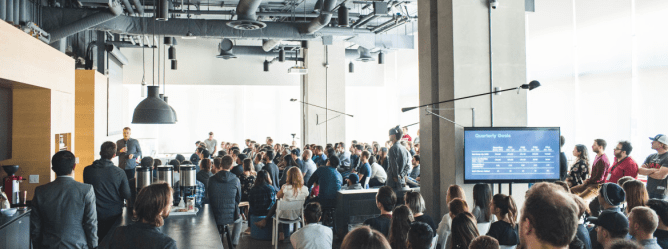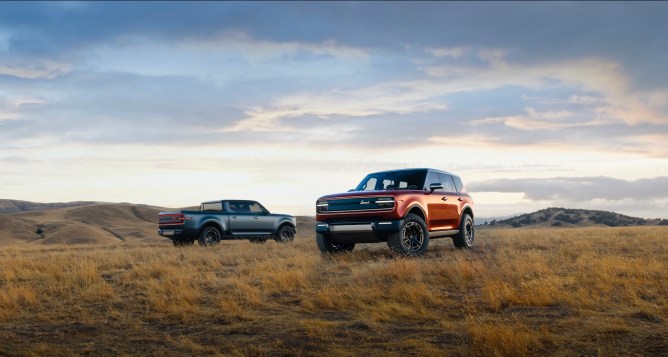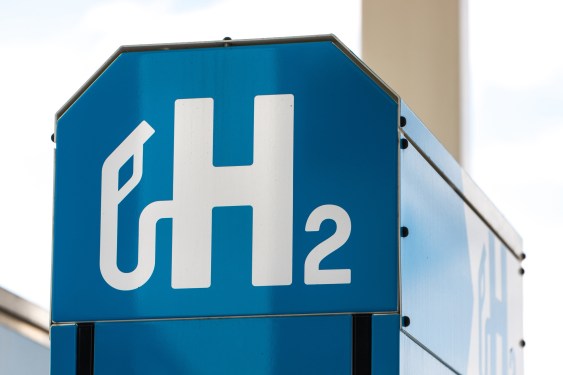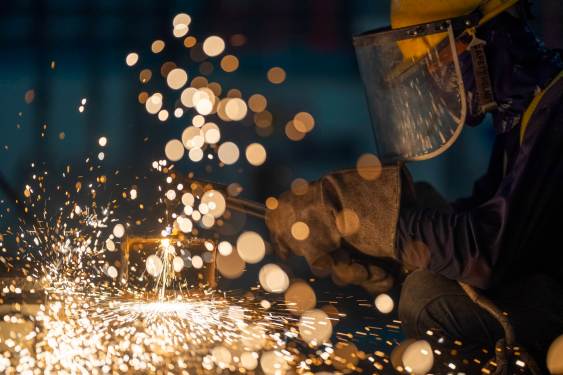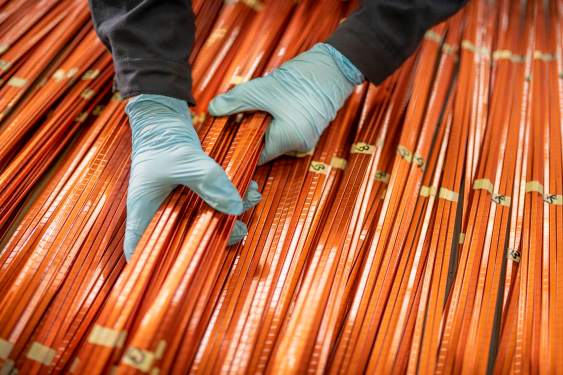Before Gene Berdichevsky became the co-founder and CEO of battery chemistry company Sila Nano, he was the seventh employee at Tesla Motors. As principal engineer on the Roadster battery, Berdichevsky was one of the first people crazy enough to experiment with shoving a lithium-ion battery pack into a combustion engine vehicle. The result? The Roadster became the first highway legal serial production all-electric car fueled by lithium-ion battery cells and able to travel over 200 miles per charge.
In 2011, Sila was founded with a mission of not only building the next generation of battery chemistry, but also being able to scale it. Since then, the company has figured out how to replace the graphite in the anode of a lithium-ion cell with silicon, which Berdichevsky says makes for a denser, cheaper battery cell. He explains why:
There are four key components in a battery. The anode stores lithium when the batteries charge. The cathode stores lithium when the battery is discharged, and the lithium goes back and forth between charge and discharge, moving through an electrolyte liquid. The separator keeps them from short-circuiting.
For the last 30 years, the anode has been graphite, and that material in graphite requires a ring of six carbon atoms for one lithium atom to come and sit in the middle when the battery is charging. So it takes six carbon atoms to store one lithium atom. In silicon, you can have one silicon atom bonding with four lithium atoms. So instead of six to one, you’re one to four. You literally have 42x atomic advantage with silicon, which means you can use a lot less material to store the same amount of lithium. Essentially, you’re using a lot less material in a much smaller space to store your energy, the lithium, in the anode.
Sila’s first commercial product, released in September on the newest Whoop fitness tracker wearable, proves not only that the company’s recipe works, but that it can scale — the launch also marks Sila’s 10-year anniversary. The next step is scaling up 100x to put the same chemistry in automobiles.
The company already has joint battery ventures with BMW and Daimler and aims to provide battery chemistry for electric vehicles at scale by 2025. With nearly every major automaker promising new lineups of EVs, ensuring a sustainable and affordable battery pack is of the utmost importance.
As a battery technology pioneer, Berdichevsky is playing the long game, already thinking in terms of the next few decades worth of work, not just the next few years. He talks us through his long-term strategy, his thoughts on fundraising and his insights into the battery industry.
The following interview, part of an ongoing series with founders who are building transportation companies, has been edited for length and clarity.
What is Sila’s long-term vision?
We want to be a world leader and do for the energy storage industry what Intel did for the personal computing industry. Intel didn’t make every single chip or the motherboards or the PCs. They made the most important components whose performance drove the adoption of the devices people actually wanted, and the better the microprocessor got, the better computers got, the more people used them and the more the world changed.
The vision for the company is to drive this anode technology over time. Hopefully we’ll have other technologies that we can deploy but really scale, scale, scale for this piece right now.
More Transportation Founders
Ample’s John de Souza on the merits of B2B, company culture and investors who get it
Plentywaka founder Onyeka Akumah on African startups and global expansion
Rad Power Bikes founder Mike Radenbaugh on fueling the e-bike revolution
Via’s Tiffany Chu on the importance of govtech for planning mobility ecosystems
Einride founder Robert Falck on his moral obligation to electrify autonomous trucking
Revel’s Frank Reig shares how he built his business and what he’s planning
Arrival’s Denis Sverdlov on the new era of car manufacturing
Refraction AI’s Matthew Johnson-Roberson on finding the middle path to robotic delivery
Veo CEO Candice Xie has a plan for building a sustainable scooter company, and it’s working
Outdoorsy co-founders detail how they expanded the sharing economy to RVs
Kodiak Robotics’ founder says tight focus on autonomous trucks is working
Zūm CEO Ritu Narayan explains why equity and accessibility works for mobility services
Do you have the funds you need to scale?
We have the funds we need to scale to the first part of the next step, but not the whole step. Our last funding round gave us a down payment on a much bigger plant that we’re going to be building. If we had to do it sequentially we could build the first part, but if we have the funding we can accelerate our scale.
How do you intend to scale to a larger battery pack?
We’re about scaling and industrializing scientific breakthroughs that enable the sustainable future. It’s not enough to crack the code and get the science right, that’s really half the battle. The other half is doing it in a way that’s fundamentally scalable.
One of the things we did very early on is we told our scientists and engineers they could only use global commodity inputs so that we know we can make enough for millions of cars. You can’t use anything bespoke, you can’t say we’ll figure it out later. Second, we said you had to use only what we call “bulk manufacturing” techniques, and that means you use volumetric reactors rather than planar reactors. To distinguish that, think of brewing as a volumetric reactor process versus planar reactors are more like display manufacturing, which scales much slower and is more expensive.
The third piece of scalability for us is really the fact that our technology seamlessly drops into any battery factory and they can adopt our technology to make a better battery without changing their capex. Currently, we’re working with a battery company in China that ships tens of millions of batteries every year on production lines. We essentially tell them to swap out one black powder for another and get a better battery out of it.
Why would a company be OK with just dropping your tech into existing battery packs?
Think about it this way: If you’re the owner of a 50-gigawatt-hour factory, and you swap the powder you’re buying today for Sila powder, you’re now the owner of a 60-gigawatt-hour factory with zero investment. We just helped you make more use of the investments that are already going to be made. And that’s very attractive to any CEO running a battery factory.
Our goal for customers is to provide a 20% energy density improvement with our first product. And we do that without compromising cycle life, safety, recharge time, any of the other performance metrics. We didn’t just launch this after like a three-month effort. We’ve been qualifying and working this into the production process for almost two years with Whoop. We go through the exact same rigorous qualification process that every single new battery that comes to market does. It’s just a better product coming out the other end, so it’s not that they’re okay with it. They love it.
The alternative is someone comes to them and says I’ve got this whiz-bang technology but it requires you to replace 20% of your factory with this other stuff. And battery companies are not going to take that risk, so that new company has to build their own battery factories, which is a lot less scalable.
Is silicon easier to come by than graphite?
Yes. Silicon is maybe like the third most abundant element in the world and you need a lot less of it. There are environmental impacts from making batteries. The goal as our industry matures should be to minimize those impacts. Silicon further reduces the environmental impact over graphite. Graphite’s really a mining process. Silicon is like sand and energy, made in a factory, so we can manage it to be much cleaner than the mining process of graphite.
So this is kind of opposite from what I think BASF’s strategy is, which is to focus on the cathode, right?
That’s right. And as the world expands the production, we need all of the above. Sila is not displacing graphite manufacturers today. We need a lot more of everything we’ve got, but over time, by 2050 let’s say, our view is we’re gonna have these new chemistries across the majority of that. They are going to be better; they’re going to be cheaper; they’re going to be longer lasting.
How do you think the industry at large has changed since you’ve been involved, and what do you think has driven that change?
From our vision, nothing’s changed in a decade. This was all part of the original plan. But what has changed is the world’s attention to it. I think it really happened in 2020, kind of correlated to Tesla’s stock going up, but I think that’s correlation not causation. I think the entirety of the world’s investor base saw that this was inevitable.
Every automaker that we talked to, every CEO I talk to now who still makes gas cars, says that EVs are more important than the gas cars now. That shift has been dramatic in the last two years. But the thing you have to remember about carmakers is they have to start the new platform five years ahead. And so they’ve all started their EV-first or EV-only platforms, and that’s why the investment is leading. That die is cast, so that transformation is going to happen.
Speaking of Tesla, would you want to be their supplier one day?
We’ll supply anyone and everyone who wants to make radically better electric vehicles. So we’ve announced partnerships we have with BMW and Daimler, and we work with others that aren’t announced yet. We’re not exclusive to anybody, and ultimately, our goal is certainly to supply the entire industry if we can.
You’ve worked at Tesla so what’s your opinion on their battery strategy? Do you think that there’s ways to improve on it?
With Sila technology it’s only going to get better, but I think they’re doing what we’re seeing the entirety of the automotive industry doing, which is to move to more vertically integrate. So I don’t think battery makers are going to go away — the LGs and Panasonics of the world are going to make a lot of batteries, but the demand is so big that they just can’t keep up, and that’s why you’re seeing Tesla and Toyota and others building their own batteries.
And I think that’s the right approach. If I were running a car company I’d have three people in engineering reporting to me. I’d have the person responsible for batteries, the person responsible for software and the person responsible for the rest of the car, because that’s really what it is. It’s a battery with software, and then a nice design around it for the user. So I think we’re seeing the industry transforming to this, and as has been the case historically, Tesla was the first to say we’re vertically integrating and then I think six months later VW said they’re doing it and that’s off to the races.
When you look at all of the promised but yet to be delivered EVs that are coming to market, does that concern you at all? Do you think we’re prepared to supply the batteries and the parts needed in a sustainable way?
There will be shortages, but that’s okay. Look at solar. Solar has been scaling up for the last 20 years. A huge amount of our team scaled solar to the point where it’s so economical and cheaper than coal and now they’re helping to scale our technology. There were times in the solar industry where certain input prices spiked and solar prices spike for a year or two here or there. None of that lasts.
When you go from 1% production of something to 10% production of something over a short period of time, it’s insanely hard to predict how to invest capital efficiently, even in a purely capitalist market. But going from 10% to 20%, which is the same increase in capacity, is a lot more predictable. And so, we are in for some shortages over the near term. I think of this on half a century timescale, so let’s say the next 10 years, there’ll be pinch points, but it’s going to be irrelevant in 2040 when all new cars sold are electric and most cars on the road are electric.
Where do you expect Sila to be a year from now?
Whoop is our first customer, we’ve got some others in the queue, so I want to have a few customers in the field. We’ll have shipped millions of devices in the field. But really we’re heads down back to work on scaling. The scale we have today can support maybe a few tens of millions of small consumer mobile devices. We’ve got to get to a billion phones and a million cars, so a year from now, we’re just right back in the thick of scale up and design of the next generation of reactors, the next generation factory, the next generation product. It’s a marathon. I think we’ve hit some important mile markers, but it’s like, what do you do after you finish running that mile? You run another mile.
Where do you see the future of the industry?
This will be a very long journey. The 20th century was the century of combustion science and fossil fuels. By the time we’re done, this will be the century of energy storage and renewables, but that means it’s gonna take a long time to get every car electric, to make all grids renewable. We just closed the first decade and chapter on our company. The next decade is scaling and then the next decade is scaling a lot more. People really underestimate the sense of scale. That’s why the technology itself doesn’t totally matter. What matters is scaling in order to actually achieve an energy transformation.



